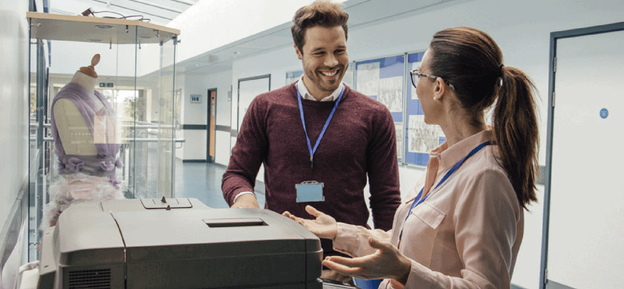Are Schools Squandering Taxpayer Dollars on Printers? Experts Demand Smarter, More Sustainable Solutions

In an era where education budgets are under intense scrutiny, a surprising expense is drawing criticism from parents, taxpayers, and sustainability advocates alike: school printers. While technology has transformed classrooms in recent decades, the reliance on traditional printing methods remains a significant financial and environmental burden. With schools nationwide grappling with rising printer costs, experts are calling for smarter, more sustainable solutions to reduce waste and maximize taxpayer dollars.
The High Cost of Printing in Schools
Printing may seem like a minor expense compared to larger budget items such as teacher salaries or infrastructure projects, but the reality tells a different story. According to a recent analysis, the average school spends thousands of dollars annually on printer maintenance, ink, and paper. Some larger districts report printer costs running into hundreds of thousands of dollars each year.
Ink, in particular, is one of the most expensive commodities in education. In some cases, it can cost more per ounce than luxury perfumes or fine champagne. When combined with the frequent need for printer repairs and replacements, these expenses quickly add up, forcing schools to divert funds that could be better spent on student resources, teacher training, or updated technology.
The situation becomes even more problematic when factoring in inefficiencies such as unnecessary print jobs, outdated equipment, and improper disposal of used cartridges. These practices contribute not only to financial waste but also to environmental harm.
Are Schools Failing to Embrace Digital Transformation?
Despite the growing availability of digital tools and platforms, many schools remain heavily dependent on printed materials. While physical copies are essential in some instances, such as standardized tests or legal documentation, experts argue that much of the current printing could be replaced with digital solutions.
“Education has yet to fully embrace the potential of paperless systems,” notes Dr. Emily Carter, an expert in educational technology. “By transitioning to digital workflows, schools could save millions annually while also reducing their environmental footprint. This shift is part of a larger educational transformation, where digital tools and sustainability efforts are reshaping the way schools operate and interact with students”.
Digital alternatives, such as cloud-based learning platforms and electronic communication tools, offer schools the opportunity to reduce their reliance on printers significantly. Platforms like Google Classroom, for example, allow teachers to distribute assignments, collect homework, and provide feedback without ever touching a piece of paper.
Sustainable and Cost-Effective Solutions
In response to rising printer costs, some schools and districts have already begun exploring more sustainable practices. For instance, implementing managed print services (MPS) has become a popular strategy. These services assess a school’s printing needs, optimize printer placement, and enforce limits on print volumes, ultimately reducing waste and costs.
Additionally, some organizations now offer free printers for schools, helping reduce upfront equipment costs. These programs often come with strings attached, such as the requirement to purchase ink or maintenance services from specific providers, but they still present a viable option for cash-strapped districts looking to minimize expenses.
Another promising development is the adoption of eco-friendly printing practices. Schools are increasingly turning to recycled paper, energy-efficient printers, and refillable ink cartridges to reduce their environmental impact. Combined with robust policies to limit unnecessary printing, these changes can make a tangible difference in both cost savings and sustainability.
What Experts Recommend
Experts in education and sustainability have called for systemic changes to how schools approach printing. Among their top recommendations are:
- Conducting Printing Audits: Schools should regularly evaluate their printing habits to identify inefficiencies and eliminate wasteful practices.
- Investing in Digital Infrastructure: Prioritizing tools like tablets, laptops, and cloud-based platforms can reduce the need for printed materials while enhancing student engagement.
- Implementing Print Quotas: Setting limits on how much staff and students can print encourages mindful printing habits and reduces unnecessary expenses.
- Partnering with Eco-Friendly Providers: Working with suppliers who offer sustainable products and services ensures that schools contribute to broader environmental goals.
- Educating Stakeholders: Raising awareness among teachers, students, and administrators about the financial and ecological costs of printing can lead to more responsible behavior.
The Environmental Case for Smarter Printing
Beyond financial concerns, the environmental impact of school printing is significant. Globally, the production of printer paper contributes to deforestation, greenhouse gas emissions, and water pollution. Additionally, discarded ink cartridges and obsolete printers often end up in landfills, where they can leach harmful chemicals into the soil and groundwater.
By adopting more sustainable printing practices, schools have an opportunity to serve as role models for the next generation. Teaching students about the importance of reducing waste and conserving resources can instill lifelong values that extend beyond the classroom.
Learn More About Cost-Effective Printing Solutions
Curious about how your school or district can save money while adopting more sustainable practices? Visit https://www.officecopiers.co.uk/free-printing-for-schools-colleges-universities.html to explore free printing programs designed specifically for schools, colleges, and universities. Discover how innovative solutions can reduce costs, minimize waste, and enhance your educational environment today.
